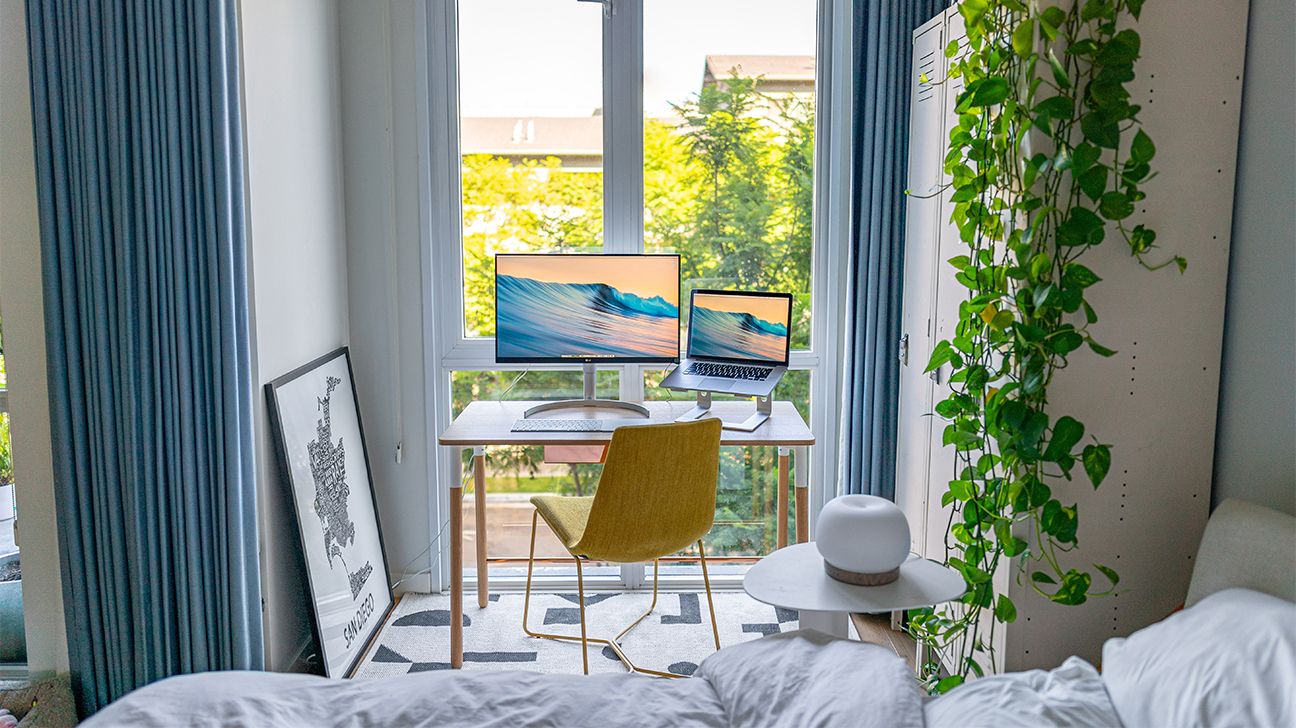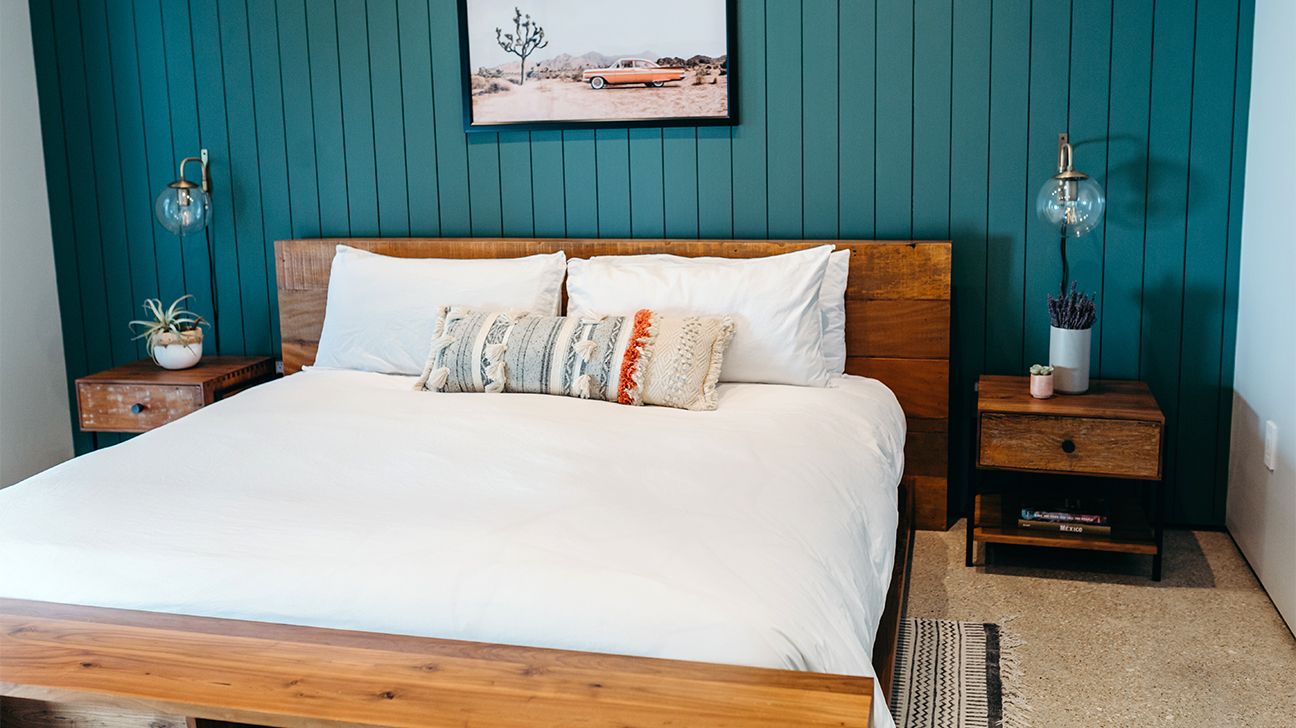
There’s something about the emptiness or untidiness of an undecorated room that instantly strikes anxiety into the heart of a type A personality. But a bigger question looms — where to start? Thinking about choosing everything from the ground up in a room can feel daunting. Instead, the best way to decorate a bedroom is to take it step-by-step. One decision leading to the next. We chatted with Austin, Texas interior designer Cameron Getter for some tips on pulling the space together.

Start the process by pulling inspiration — other bedrooms you like or products you love from Pinterest, Instagram, or magazines.
One of the first decisions you’ll need to make is whether you’re going to paint. “I generally tell my clients, when you’re starting a whole room to carefully consider the paint. It’s your backdrop and it’ll determine the direction of everything else,” says Cameron.
Consider if you want the room to feel light and bright or darker and moodier? “You do want to consider the function of the room. Since a bedroom is all about relaxation and sleep, the color should reflect that,” she says. “Right now, neutrals, blues, and greens are really on trend for bedroom spaces.”
Think of the floor and rug in a room like another wall. It might seem random to pair choosing a rug and artwork at the same time, but these accessories will help inform the rest of the pieces in the room — you can pull colors from them and it’s a jumping off point.
You want the colors to complement the paint and include tones that can repeat in furniture and accessories too. “A bedroom is a chance to invest in a plush more luxurious rug, or something with a high pile that’s softer to walk on but will get less dirty tucked away in a bedroom,” says Cameron.
As for rug size, go as large as you can for the space. Typically, people can use an 8×10 or 9×12 in a bedroom. When choosing a rug, balance is important. If you have neutral or white walls, you might play up color in your rug and vice versa. If you prefer an all-neutral look, make sure you vary the textures in the room, so they feel dynamic and layered.
Think practical first. What are your needs in the room? Do you have closet space or do you need external storage? What size is your bed? Is there room for two nightstands? Think about what you need based on how you live in the room, and then move to the aesthetics. “Start with the bed frame or headboard. The bed is the focal point in the room,” says Cameron. “The wood tone or finish will help guide the choices of the other pieces of furniture like the dressers and nightstands.”
These days bedroom sets are out, and a more pulled together and eclectic look is in. “Mixing finishes can seem daunting, but it’s all about balance. You want the items to feel related, but not matching. Make sure the undertones in the pieces are the same and can match up,” Cameron says.
Start with your overhead lighting — are you going to do a flush mount or hanging fixture or a ceiling fan? Some people need the white noise and air circulation a fan provides for sleep, and you could opt for a fan with a light.
Now, it’s time to add some ambient lighting. This is the light you’ll use when you get into bed if you’re reading or scrolling through your phone before you tuck in for the night. You’ll want some sort of small table lamp or a wall-mounted sconce. “The lamps in a room are an opportunity to have some fun and show off your personal style. But they’re an opportunity to bring in texture, so maybe they should be metal or rattan. Think about the other textures and finishes in the room to pull everything together,” says Cameron.
Bulb tone is important, too. Make sure you’re using a flattering, warm white light that isn’t going to look too harsh. There are even smart bulbs available that mimic natural light shifts and help support a natural circadian rhythm.
Again, start with the functionality of your bed. What do you need? Do you want it to feel pared-down and minimal or thick and layered?
Here’s the winning formula that Cameron swears by: A fitted sheet, a top sheet, your sleeping pillows, then your shams (Euro or standard), then a decorative lumbar if you’d like. From there, lay a coverlet on the bed and then your duvet. Fold your duvet down at the foot of the bed for volume. And add a throw blanket, too.
You don’t have to complicate bedding. “Get something neutral that will hold up beyond what’s trendy. If you want a little fun, try a colorful or patterned top sheet,” she says. “But balance the bedding with the rest of the room if you have a busy rug or curtains. Don’t feel like you have to get busy bedding.”
Think about the decorative element and the practical. Do you need blinds for privacy? “My go-to is a blackout liner on a Roman shade, but you can do wood blinds with curtains too,” says Cameron. Curtains are an opportunity to add additional color or texture.
Make sure you mount the curtain rods higher than the window frame when you hang them. It creates the look of higher, more dramatic ceilings.
Less is more here. You don’t want to clutter your space with decorative items that collect dust.
“Plants are a great way to bring in greenery and organic texture,” says Cameron. Just make sure that the room gets enough light for the variety you’ve chosen.
From there, accessories like trays and baskets will help keep you organized and the visual clutter to a minimum. Another detail that can make a room feel especially luxe is an essential oil diffuser. Many people enjoy drifting off to sleep using one.
If you feel overwhelmed by budgeting, don’t forget to check local secondhand options, from Facebook Marketplace, to Craigslist, even Nextdoor to decorate your bedroom. Local flea markets, Etsy and eBay are also fantastic resources for art, throws, rugs and other accessories. If you can’t find the perfect lamp, rug or throw pillow, etc., hold out until you find the one. It’s worth the wait.
Caylin Harris is a writer, crafter, and stylist specializing in interior design and DIY. She lives in New England and loves scoring the perfect vintage find, reading, gardening and giving guests restaurant recommendations. She lives with her husband and rescue cats in their own fixer upper.
